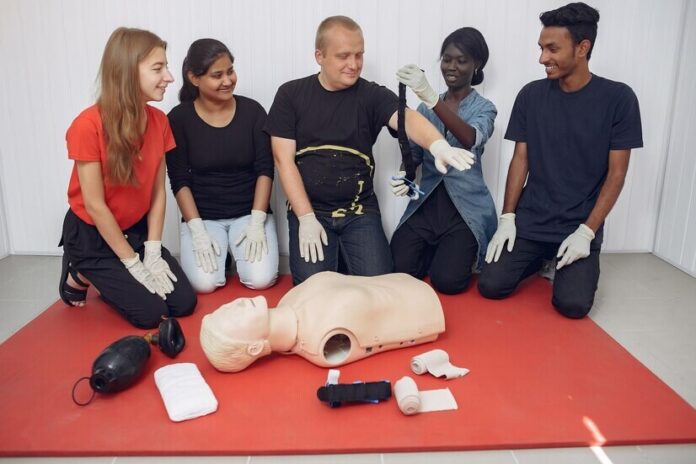In the case of accidents, saving a few precious seconds might be the difference between life and death.
Hence, there is no one out there who should not take Basic Life Support training. Anyone can take Basic Life Support (BLS) training and be equipped with the simple yet necessary actions that must be taken during such times.
BLS includes skills like CPR, the use of AED, and management of the airway, all of which are critical in keeping a patient’s circulation and breathing going until further assistance is sought from a doctor.
Whether you are a doctor, nurse, paramedic, educator, or want to be ready for the worst, BLS training puts the power to save a life in your hands.
This article presents details on what BLS entails, why training in BLS is crucial, and the available certification as a valuable guide to anyone who wishes to gain or renew BLS skills.
What is Basic Life Support (BLS)?
Basic life support refers to the treatment that is offered to individuals who are in critical condition before they are taken to a hospital for further care.
BLS training involve performing CPR, using AEDs, and clearing foreign objects from the airway.
The main objective of BLS is to ensure that the flow of blood and air to the patient’s body is intact before the arrival of more sophisticated care.
Components of BLS Training
BLS training includes several vital components.
- Cardiopulmonary Resuscitation (CPR)
CPR is an effective rescue procedure that involves a combination of chest compressions and breathing to ensure adequate circulation of blood and oxygen during the arrest. It includes.
- Chest Compressions: Pressure is applied on the center of the chest with a depth of 2 inches in adults, and the chest is compressed 100-120 times per 60 seconds.
- Ventilations: Oxygen is given by placing the patient’s face over a bag, and the patient prefers to give two breaths for every 30 chest compressions.
- Automated External Defibrillator (AED) Use
An AED is a transportable medical device that is used to deliver electric shock to the heart in a case of sudden cardiac arrest. BLS training teaches individuals how to:
- Identify the symptoms of cardiac arrest.
- Self-administer an AED correctly, which involves placing the pads in the correct areas and following the machine’s instructions.
- Airway Management
Airway management entails methods of keeping the airway of a particular patient unobstructed to allow breathing. This includes.
- Head Tilt-Chin Lift: A technique employed in clearing the airway of an unconscious patient.
- Jaw Thrust: A head tilt-chin lift is an additional technique that may not be used in a spinal injury case but is a viable technique when a head tilt-chin lift is impossible.
- Heimlich Maneuver: A procedure for removing obstructing objects in the airway from a conscious patient.
The Importance of BLS Training
BLS training is essential for a variety of reasons.
- Increases Survival Rates
Early and efficient BLS can significantly influence the possibility of a positive outcome in cases of cardiac arrest and other critical situations. This is especially the case with bystander CPR, which has been scientifically proven to increase the survival rates by at least double or, in some cases, triple.
- Empowers Individuals
CPR certification teaches people how to respond effectively and calmly when faced with an emergency. This preparedness can be the determining factor between living to tell the story or succumbing to the disease or any other condition on the operating table.
- Reduces Response Time
If more individuals are trained in BLS, then basic first aid can be given before actual medical professionals reach the scene. This helps to minimize the response time for critical situations in emergency cases.
- Enhances Community Safety
A community with a population of people with BLS training provides better responses to emergencies and, thus, improves community safety.
Who Should Take BLS Training?
BLS training is beneficial for a wide range of individuals.
- Healthcare Professionals: Physicians, surgeons, and other medical professionals, including nurses, emergency medical technicians, and paramedics, usually attend to patients at the onset of medical crises.
- First Responders: First responders include firefighters, police officers, and other personnel in the emergency services.
- Teachers and Coaches: People who are concerned with the welfare and safety of children and athletes.
- Corporate Employees: Especially those in high-risk industries such as construction, oil and gas, chemical industry, and healthcare.
- General Public: Any individual who would like to be ready for assistance in case of an emergency.
Tips for Effective BLS Training
Consider the following advice to get the most out of your BLS training.
- Get Regular Practice
It takes consistent practice to keep up BLS proficiency. Create lifelike settings by training AEDs and using manikins.
- Remain Current
The most recent findings in science are used to update BLS best practices and standards on a regular basis. Read pertinent books and take refresher classes to stay up to date on these developments.
- Make Use of Technology
These days, a lot of BLS courses use cutting-edge technology to improve learning and retention, such as smartphone applications and virtual reality (VR) simulations.
- Take Part in Team Building Activities
BLS is frequently carried out in groups, particularly in formal contexts. Participating in team-based training enhances coordination and communication in real-world situations.
Bottomline
Training in Basic Life Support (BLS) is a vital skill that may save lives in emergency situations.
The BLS program gives you the information and abilities you need to respond quickly and effectively in an emergency, whether you work in healthcare or are just seeking to be prepared for life’s little surprises.
Make the neighborhood safer and more receptive by comprehending the elements, significance, and certification process. Recall that every second matters in an emergency situation, and having BLS training helps.




